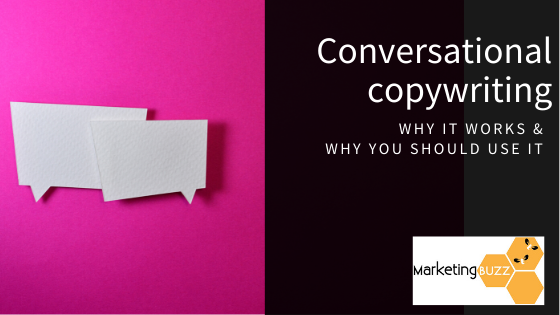Conversational copywriting. It’s writing that sounds like a real-life conversation.
But it’s not just any old conversation.
The aim is to sell but without the hype. Without the BS.
Conversational copywriting has become a more popular way of communicating on websites, blogs, social media and in ads.
And there are good reasons why.
-
Conversational copywriting is perfect for the web
A conversational style works well when you’re appealing to an online reader.
Your typical online reader scans. They skim the ‘page’, not spending the time to read every word.
When your message is written in an appealing tone, makes good use of headings and subheadings and gets to the point, it has more chance of being read and understood.
-
Conversational copywriting helps communicate empathy with your reader
With conversational copywriting, your reader should feel that it’s not all about you.
You understand the reader’s point of view. You’re there to offer value and help them make their life a little better.
It means less sell and more honest, transparent communication.
-
A clearer message leads to a better connection
A message that’s brief and clear is easier to understand.
And isn’t that always your goal? To have your message understood by your prospect or client?
It’s not about dumbing things down. It’s about using plain language so that your audience gets what you’re all about.
Copywriting that’s clear and succinct doesn’t make people work hard. It doesn’t confuse. (Why would you want to do that?)
Even if you work in a specialised, technical area, it’s important to keep it straightforward. Making difficult topics easy to understand should be your superpower.
Always ask yourself ‘is my audience going to easily understand this content?’.
-
Striking the perfect tone of voice
Tone of voice is about how we want people to feel when they read our copy.
Working out the characteristics of your ideal tone of voice is important before you get writing.
Think about where you fall on these four criteria:
- Funny – Serious
- Formal – Casual
- Respectful – Irreverent
- Enthusiastic – Matter of fact
Three important aspects of matching your tone of voice with your audience are:
- Understanding who you’re writing for
- Knowing why someone would read your content (what’s their goal?) and
- Understanding what result are you’re looking for (what do you want your audience to do?).
-
Sounding like a human is a good thing – even in business-to-business communication
Even if you work in a business that’s selling to another business, writing as if you’re connecting to a real person makes sense, doesn’t it?
I’ve been around long enough to know it’s not how we used to think you should communicate in a ‘business’ setting.
The traditional way of communicating was more formal. It tended to use passive language. That’s where you might say “the product was introduced” rather than “we introduced the product”.
Traditional business writing often included more formal words and phrases.
You needed to give the impression that you knew your way around a dictionary.
As well as striking the right tone of voice, using contractions – ‘we’ve’ instead of ‘we have’ – helps make your writing sound more personal. You’ll also use the word ‘you’ and ‘your’ more than ‘we’ or ‘us’.
Conversational copywriting doesn’t necessarily throw out grammar. But it doesn’t sweat over it.
Real words for real people
Finding the right balance in your marketing communications will help you connect to your audience.
A conversational-style of writing strives to connect to the reader – to connect as if you were having a conversation with a friend or someone you know.
And most people prefer to buy from someone they know, trust and like, don’t you agree?






